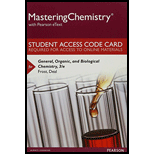
Concept explainers
a.
To determine:
The representation of atoms that are black spheres in the ball-and-stick model.
Concept introduction:
Ball-and-stick model gives the three dimensional representation of molecular compounds. It clearly displays the bonds between the atoms and the atoms are represented by spheres.
Each chemical element is represented by spheres of different colors. In this model there is a good visualization of geometries that are difficult to see on paper. The bond lengths between the two atoms are represented by sticks and the atoms are represented by balls.
b.
To determine:
The representation of atoms that are red and small gray spheres to the right of it in the ball-and-stick model.
Concept introduction:
Ball-and-stick model gives the three dimensional representation of molecular compounds. It clearly displays the bonds between the atoms and the atoms are represented by spheres.
Each chemical element is represented by spheres of different colors. In this model there is a good visualization of geometries that are difficult to see on paper. The bond lengths between the two atoms are represented by sticks and the atoms are represented by balls.
Want to see the full answer?
Check out a sample textbook solution
Chapter 4 Solutions
Mastering Chemistry with Pearson eText -- Standalone Access Card -- for General, Organic, and Biological Chemistry (3rd Edition)
- all stereocenters. Add notes above or below an arrow heat Click and drag to start drawing a structure.arrow_forwardReplace one of the H atoms in the ethane model with a Br atom, to form ethyl bromide CH3CH2Br, and draw a projection (lewis) and a perspective drawing. Does replacing different hydrogen atoms in CH3CH3 to produce Ch3CH2br give you different isomers? (i.e. Are all the hydrogen atoms equivalent?) How many isomers of CH3CH2Br can you construct? Make a model of one other conformer of CH3CH2Br. DId you need to break any bonds to form the second conformer from the first?arrow_forwardwhat is the structure and jvalues? (c10H14O).arrow_forward
 Introductory Chemistry: An Active Learning Approa...ChemistryISBN:9781305079250Author:Mark S. Cracolice, Ed PetersPublisher:Cengage Learning
Introductory Chemistry: An Active Learning Approa...ChemistryISBN:9781305079250Author:Mark S. Cracolice, Ed PetersPublisher:Cengage Learning Introductory Chemistry: A FoundationChemistryISBN:9781337399425Author:Steven S. Zumdahl, Donald J. DeCostePublisher:Cengage Learning
Introductory Chemistry: A FoundationChemistryISBN:9781337399425Author:Steven S. Zumdahl, Donald J. DeCostePublisher:Cengage Learning Chemistry for Today: General, Organic, and Bioche...ChemistryISBN:9781305960060Author:Spencer L. Seager, Michael R. Slabaugh, Maren S. HansenPublisher:Cengage Learning
Chemistry for Today: General, Organic, and Bioche...ChemistryISBN:9781305960060Author:Spencer L. Seager, Michael R. Slabaugh, Maren S. HansenPublisher:Cengage Learning Organic Chemistry: A Guided InquiryChemistryISBN:9780618974122Author:Andrei StraumanisPublisher:Cengage Learning
Organic Chemistry: A Guided InquiryChemistryISBN:9780618974122Author:Andrei StraumanisPublisher:Cengage Learning Chemistry & Chemical ReactivityChemistryISBN:9781133949640Author:John C. Kotz, Paul M. Treichel, John Townsend, David TreichelPublisher:Cengage LearningChemistry: Matter and ChangeChemistryISBN:9780078746376Author:Dinah Zike, Laurel Dingrando, Nicholas Hainen, Cheryl WistromPublisher:Glencoe/McGraw-Hill School Pub Co
Chemistry & Chemical ReactivityChemistryISBN:9781133949640Author:John C. Kotz, Paul M. Treichel, John Townsend, David TreichelPublisher:Cengage LearningChemistry: Matter and ChangeChemistryISBN:9780078746376Author:Dinah Zike, Laurel Dingrando, Nicholas Hainen, Cheryl WistromPublisher:Glencoe/McGraw-Hill School Pub Co





